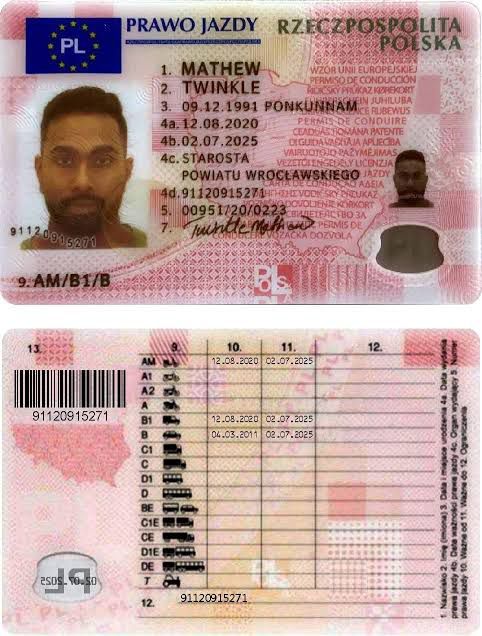What Is The Reason? Driving Licenses B Is Fast Becoming The Most Popular Trend For 2024
Understanding Driving Licenses: Types, Requirements, and Frequently Asked Questions
Driving is an essential element of contemporary life, and acquiring a driving license is a vital milestone for lots of people. This post explores the numerous types of driving licenses available, the requirements to obtain them, and responses frequently asked concerns connected to the topic. A well-informed perspective on driving licenses can assist people understand the importance of picking the correct type of license to fulfill their needs.
Types of Driving Licenses
Driving licenses can vary between countries and areas, but they normally fall into several significant categories. The following table summarizes the most common types of driving licenses, including their functions and common constraints.
Kind of License
Description
Typical Restrictions
Eligibility Age
Student's Permit
Enables newbie drivers to practice.
Should drive with a certified adult.
16-18 years of ages
Class C License
Requirement license for guest lorries.
No limitation on variety of passengers.
18 years or older
Class A License
Business license for big vehicles.
Must comply with stricter guidelines.
21 years or older
Class B License
For driving buses and bigger cars.
May need unique endorsements.
21 years or older
Bike License
For running bikes.
Need to wear a helmet; differs by state.
16-18 years of ages
International License
Enables legal driving in foreign countries.
Must have a legitimate domestic license.
18 years or older
Student's Permit
The student's permit is the initial step for many individuals venturing into the world of driving. This authorization enables newbie drivers to practice driving under supervised conditions, normally needing a licensed adult over a particular age to accompany them in the vehicle.
Class C License
The Class C license is the most frequently held driving license, enabling people to operate basic guest cars. This license typically has actually less restrictions compared to other classifications.
Class A and B Licenses
Class A and B licenses are essential for running commercial automobiles. These licenses require special training and testing, ensuring that motorists are geared up with the abilities needed for steering bigger and more complex cars safely.
Bike License
Individuals interested in riding motorbikes should obtain a motorbike license, which can require extra training and screening. haywoodloven.top , such as helmets, is typically mandated by law.
International License
A global driving license makes it possible for people to drive in foreign countries, but it is essential to have a valid domestic driving license in conjunction with the global authorization.
Requirements to Obtain a Driving License
The requirements for getting a driving license can differ substantially by jurisdiction. However, there are common steps and criteria that most candidates will come across. Below is a list of basic requirements:
Age Requirement:
- Minimum age differs; learner's permits are frequently provided at 16, while full licenses might need applicants to be 18 or older.
Vision Test:
- Most jurisdictions need applicants to pass a vision test to ensure safe driving abilities.
Written Test:
- New chauffeurs should pass a composed exam that covers traffic laws, roadway indications, and safe driving practices.
Driving Test:
- Practical driving tests are performed to show an applicant's ability to run an automobile safely under various conditions.
Costs:
- Payment of application and screening costs is normally required.
Proof of Identity:
- Applicants must supply legitimate identification, such as a passport or birth certificate, along with evidence of residency.
Adult Consent (for minors):
- Parental or guardian authorization is typically needed for candidates under the age of 18.
Understanding the various types of driving licenses and their associated requirements is vital for anyone looking to drive lawfully and safely. Each license serves a distinct purpose, catering to different driving requirements, from basic lorries to commercial transport and motorcycles. By fulfilling the necessary criteria and adhering to regulations, striving motorists can delight in the liberty of driving while guaranteeing their security and the safety of others.
Regularly Asked Questions (FAQs)
What do I need to bring when using for a driving license?
- You usually need to supply recognition, evidence of residency, and any necessary application costs. Talk to your regional DMV or licensing authority for specific requirements.
The length of time does it require to acquire a driving license?
- The timeline can differ based upon individual scenarios, such as how quickly one can finish the needed tests, and whether there is a stockpile at the licensing authority.
Can I drive with a student's license?
- Yes, but you need to be accompanied by a licensed motorist and stick to constraints set by your local laws.
What happens if I stop working the driving test?
- You normally have the alternative to retake the test after a designated waiting period, which differs by jurisdiction.
Is it required to take a driving course?
- While not always mandatory, taking a motorist's education course can be advantageous and is typically required for people looking for a learner's authorization.
By being informed about the types of licenses readily available, the requirements required for acquiring one, and the associated regulations, possible drivers can navigate the process of getting a driving license with confidence.
